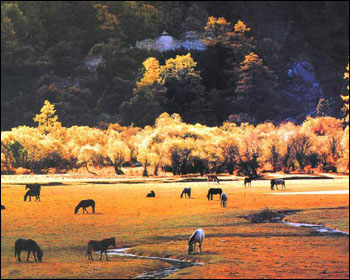| Tools: Save | Print | E-mail | Most Read |
| The Pilgrims of Langmusi |
| Adjust font size: |
Murmuring an unbroken stream of prayers, and focused intently on a scarlet and silver monastery bathed in morning light and incense smoke, four Tibetan women fell to their hands and knees in succession. They laid face down before standing up to clasp their hands in prayer for their three hundredth prostrate atop the snow-dusted hilltop on the
But the solemn chants of these devout Buddhists soon dissolved into the self-conscious giggles of young girls upon sensing the presence of a foreigner. Using the moment as an entertaining respite from their prayers, they beckoned to see the pictures I had just taken of them, the site of themselves on my digital camera bringing even louder laughter. Located at an altitude of some 3,000 meters in the mountains of western China, and literally straddling the Gansu-Sichuan border, the rustic, plank-rooftop settlement of Langmusi, and the two glittering Buddhist temples of which the town architecturally and spiritually orbits, is one of those places that can best be described as heavenly. Gansu itself is one of China's most dramatically varying regions both topographically and culturally, extending in a long, narrow arch from the mountain-sized sand dunes of Dunhuang in the northern Hexi corridor to the verdant Ganjia grasslands in the provincial interior. South of the Muslim metropolises of Langzhou and Lingxia, gleaming mosques become sub-bleached stupas and the white-capped Hui people relinquish the landscape to prismatic Tibetans spinning prayer wheels beneath the surreal blue sky, living up to its provincial sobriquet, "Little Lhasa." Following their morning prayers, the three pretty sisters and their mother, each regally draped in heavy, black cloaks and adorned with layers of florescent orange coral necklaces and hefty belts of silver, invited me back to their home. It wasn't their real home, they explained, but temporary living quarters. Like so many of the Sichuanese-Tibetans who comprise the town's nomadic population, they were completing their pilgrimage to the Langmusi and Labuleng monasteries in nearby Xiahe before making their way back home to northern Sichuan. Nestled within a small community of shanties, their humble clay dwelling was no larger than the sleeper cabin of a train and housed this family of six. Keeping the fire burning, preparing lunch and babysitting his baby granddaughter when we arrived, was the patriarch of the family.
His own three daughters ranged in age from 16 to 25 and received only basic schooling, preferring to raise families and follow their parents on their spiritual pilgrimages. Income, most which was spent on such journeys, is earned by the father and the elder sister's husband, who breed horses in the I asked the father and mother to which Tibetan ethnolinguistic category they belonged (i.e. For Tibetans, family and faith, not politics and ethnic divisions, are the most important aspects of their lives. Unfortunately, only the family's father and mother have made the arduous and expensive pilgrimage to the holy capital city of Lhasa in the Tibet Autonomous Region, a journey that takes many Sichuanese- Tibetans years to save for, lest they must beg on the streets for alms to make their way west. But the three sisters are saving their jiao and listened in awe as I told of my own extensive travels the previous year across Promising to send them the family portraits I took, we professed our mutual thanks and respect and parted ways, they to spend the second half of their day making 400 koras (spiritual walking circuits) around Langmusi and me to watch, though now with a better understanding of who I was watching. Travel Tips How to get there: From the capital city of Where to stay: There are a growing number of inns and hotels on Langmusi's only thoroughfare, from £¤20 to £¤150 per night. What to eat: Leisha's is a favorite with backpackers, boasting massive yak burgers and homemade apple pie. Where to play: Pilgrim watching around the Sezhi Monastery on the (Cityweekend by Thomas Carter June 21, 2007)
|
| Tools: Save | Print | E-mail | Most Read |
 |
| Related Stories |
|
|
Product Directory China Search |
Country Search Hot Buys |

